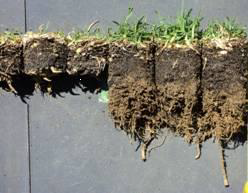Sting nematode on turfgrass
The sting or southern sting nematode (Ibipora lolii) is a tiny worm that causes discoloured patches on turfgrass and can be managed as described here.
Even when fully grown, the sting nematode is only about 3mm long. However, in large numbers they can severely affect the visual appeal of bowling greens and golf courses.
Symptoms
The most obvious signs of sting nematode infestation are irregular, discoloured and thinning patches on turfgrass that do not respond to fungicides, irrigation, fertilization or aeration and become overrun by weeds. Below ground signs are short stubby roots and a reduction in the fine feeder roots.


Environment and spread
Sting nematodes live in the soil. They feed by inserting their stylet into roots, injecting enzymes and then sucking out nutrients. Sting nematodes prefer soils with a high sand content, especially if well irrigated. Nematodes can spread in soil on plant material, machinery and clothing or boots.
Distribution
Sting nematode is present in New South Wales, Western Australia, Queensland, South Australia and Victoria.
Host range
A full host range remains undefined but includes:
- bent grass (Agrotis stolonifera and Agrotis tenuis)
- couch grass (Cynodon dactylon)
- kikuyu grass (Pennisetum clandestinum)
- sugarcane
- perennial ryegrass.
Management options
There are options available to manage the spread of sting nematode:
- Establish turf on sites that are free of the nematode.
- If the site is infested, consider chemical treatment options to reduce nematode populations. The Australian Plant and Veterinary Medicine Authority (APVMA) has a nematicide registered for sting nematode.
- Plant turfgrasses from suppliers known to be free of sting nematode.
- Reduce stress on turfs by slightly raising the mowing height.
- Fertilise well to counter poor nutrient uptake from roots damaged by the nematode.
- Avoid excessive nitrogen fertilisation as it promotes root tip growth, providing a source of food for nematodes.
- Encourage deep root growth with deep, infrequent watering as a deep root system is more tolerant to nematode damage.
- Avoid compaction and promote aeration, which encourages a healthy root system and may boost tolerance to nematodes.
- Apply organic soil amendments that may enhance turf growth and reduce nematode damage.
- Avoid shading turfgrasses as this reduces nutrient production and storage, which lowers the turf's tolerance to nematode damage.
- When managing turf, work on healthy sites first to avoid transferring nematodes from infested sites to healthy sites.
- Consider soil solarisation if practical.
As damaged turf can be associated with a range of problems (including nematodes), obtaining a professional diagnosis from a reputable laboratory can save you valuable time, effort and pesticide treatments.
Reporting an unusual plant insect pest or disease
Report any unusual plant pest or disease immediately using our online reporting form or by calling the Exotic Plant Pest Hotline on 1800 084 881. Early reporting increases the chance of effective control and eradication.
Please take multiple good quality photos of the pests or damage to include in your report where possible, as this is essential for rapid pest and disease diagnosis and response.
Your report will be responded to by an experienced staff member, who may seek more information about the detection and explain next steps.
Report onlinePhoto credits
Figure 1 courtesy of Sarah Collins, Department of Primary Industries and Regional Development, Western Australia.
Figure 2 courtesy of Ken Johnston, Sports Turf Technology, Pty. Ltd., Western Australia.
References
Collins S (2013) Pathogen of the month – January 2013. Ibipora lolii (Siviour, 1978), Siviour & McLeod 1979. Australasian Plant Pathology Society, 4 September 2020.
Crow TW (2007) Nematode Management of golf courses in Florida. UF IFAS Extension University of Florida ENY-8, 8pp.
Smilely RW (1983) Compendium of Turfgrass Diseases, The American Phytopathological Society, pp 67–70.
Stirling GR, Stirling AM, Giblin-Davis RM, Ye W, Porazinska DL, Nobbs JM,Johnston KJ (2013) Distribution of southern sting nematode, Ibiproa lolii (Nematoda: Belonolaimidae), on turfgrass in Australia and its taxonomic relationship to other belonolaimids. Nematology 15:401 – 415.
Nambiar L, Quader M, Nobbs JM (2010) Morulaimus gigas (Nematoda: Belonolaiminae) in southern and eastern Australia. Australasian Plant Disease Notes 5:39 – 41.
Hixon AC (2015) Nematode Management of golf courses in Florida ENY-008/IN124.
APVMA Agador Turf Nematicide and Miticide, on 4 September 2020.